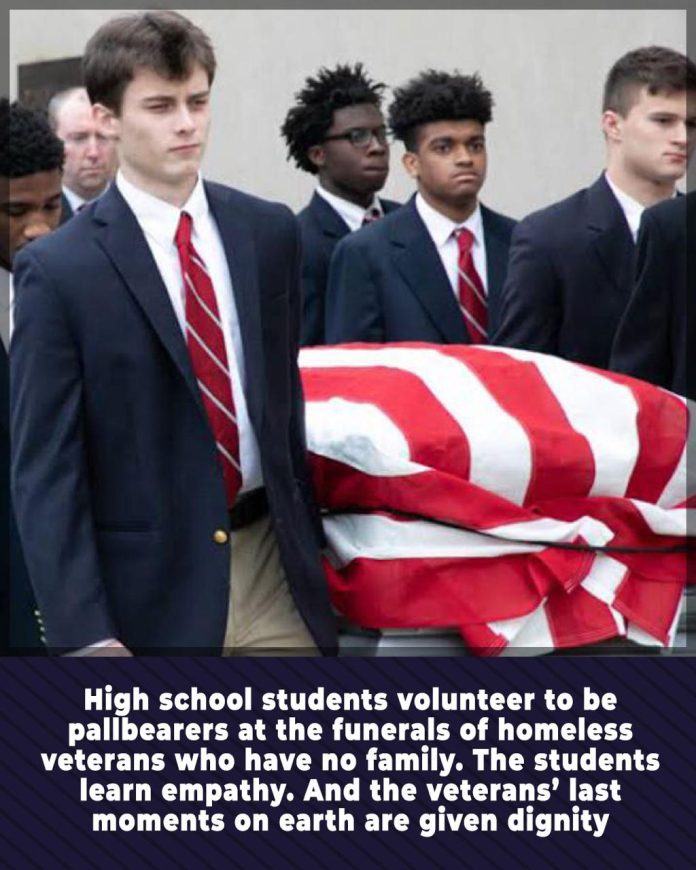Leneghan served as a pallbearer through Saint Ignatius High School’s St. Joseph of Arimathea Pallbearer Ministry, a program aimed at honoring those who pass away without family by providing student pallbearers to carry them to their final resting place.
A Ministry Rooted in Compassion

The St. Joseph of Arimathea Pallbearer Ministry at Saint Ignatius High School began in 2003 with 12 students, serving three funerals in its inaugural year. Today, the program has grown to include about 400 students annually, who volunteer for up to 180 funerals. Students like Leneghan find the experience both somber and enriching. “It makes you appreciate more of what you are, and who you are as a person,” he said.
Training for Dignity and Reverence

Programs like these involve meticulous training to ensure that students understand the solemnity of their role as pallbearer. Blaise Weidmann, a junior at McQuaid Jesuit in Rochester, New York, explained the process: “We had to learn how the casket comes out of the hearse, how we carry it… and how fast or slow we have to walk with it.” Beyond logistical skills, students are also taught to offer spiritual support, participating in prayers and hymns to honor the deceased.
A Growing Movement Across the Nation

The success of Saint Ignatius’ program has inspired similar initiatives at other schools, including Catholic Memorial in Massachusetts and the University of Detroit Jesuit High School. These programs emphasize the Christian belief in the inherent dignity of every individual, regardless of their social or familial circumstances. Richard Mazyck, a service coordinator at the University of Detroit Jesuit, articulated this perspective: “Every person is made in the image of God and is deserving of a particular regard and respect.”
Honoring Forgotten Lives

Many of the funerals served by these students are for individuals who were homeless, elderly, or estranged from family. At Potter’s Field in Cleveland, a burial ground for the homeless, Saint Ignatius students participate in annual services to honor those who might otherwise be forgotten.
Pat Valletta, who coordinates the program, recounted, “We’ve served at funerals where literally the only people in attendance are the six pallbearers, the adult that drives them, the funeral director, and the priest.”
Moments of Profound Connection

Even in the absence of family, student pallbearers can offer solace to attendees when present. Evan Solar, a senior at Saint Ignatius, recalled a moment when a simple act of handing a sympathy card moved a mourner to tears. “She broke down in tears and was just so appreciative and thankful,” he said, highlighting the deep emotional impact of their service.
Honoring Veterans

Some pallbearer programs extend their services to veterans who pass without family. Catholic Memorial, for instance, has held funeral Masses and military honors for veterans, providing them with the recognition they deserve. Peter Folan, president of Catholic Memorial, noted the transformational impact this experience has on students. “Kids begin to recognize that these are people who have sacrificed much,” he said.
A Corporal Work of Mercy

Rooted in Catholic social teaching, pallbearer programs embody a “corporal work of mercy,” a charitable act central to the faith. Adam Baber, director of service and justice at McQuaid Jesuit, described the practice as both honorable and deeply meaningful. “It’s a concrete way to put that work of mercy into practice,” he said.
Presence as the Ultimate Gift

For students like Solar, the experience of serving as a pallbearer transcends mere duty. “We’re all called to serve, and that doesn’t always look like building a well,” he reflected. Instead, he emphasized the importance of showing up and being present, a profound act of respect that leaves a lasting impression on both the living and the departed.

